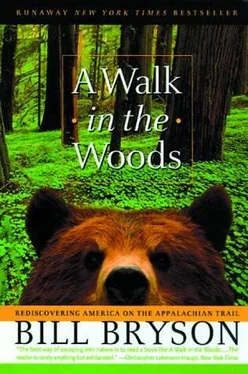Bill Bryson - A Walk In The Woods
Здесь есть возможность читать онлайн «Bill Bryson - A Walk In The Woods» весь текст электронной книги совершенно бесплатно (целиком полную версию без сокращений). В некоторых случаях можно слушать аудио, скачать через торрент в формате fb2 и присутствует краткое содержание. Жанр: Современная проза, на английском языке. Описание произведения, (предисловие) а так же отзывы посетителей доступны на портале библиотеки ЛибКат.
- Название:A Walk In The Woods
- Автор:
- Жанр:
- Год:неизвестен
- ISBN:нет данных
- Рейтинг книги:4 / 5. Голосов: 1
-
Избранное:Добавить в избранное
- Отзывы:
-
Ваша оценка:
- 80
- 1
- 2
- 3
- 4
- 5
A Walk In The Woods: краткое содержание, описание и аннотация
Предлагаем к чтению аннотацию, описание, краткое содержание или предисловие (зависит от того, что написал сам автор книги «A Walk In The Woods»). Если вы не нашли необходимую информацию о книге — напишите в комментариях, мы постараемся отыскать её.
A Walk In The Woods — читать онлайн бесплатно полную книгу (весь текст) целиком
Ниже представлен текст книги, разбитый по страницам. Система сохранения места последней прочитанной страницы, позволяет с удобством читать онлайн бесплатно книгу «A Walk In The Woods», без необходимости каждый раз заново искать на чём Вы остановились. Поставьте закладку, и сможете в любой момент перейти на страницу, на которой закончили чтение.
Интервал:
Закладка:
Sixty years ago, there were almost no trees on the Blue Ridge Mountains. All this was farmland. Often in the woods now the trail would follow the relics of old stone field walls, and once we passed a small, remote cemetery-reminders that this was one of the few mountaintop areas in the entire Appalachian chain where people once actually lived. Unluckily for them, they were the wrong kind of people. In the 1920s, sociologists and other academics from the cities ventured into the hills, and they were invariably appalled at what they found. Poverty and deprivation were universal. The land was ridiculously poor. Many people were farming slopes that were practically perpendicular. Three-quarters of the people in the hills couldn’t read. Most had barely gone to school. Illegitimacy was 90 percent. Sanitation was practically unknown; only 10 percent of households had even a basic privy. On top of that, the Blue Ridge Mountains were sensationally beautiful and conveniently sited for the benefit of a new class of motoring tourist. The obvious solution was to move the people off the mountaintops and into the valleys, where they could be poor lower down, build a scenic highway for people to cruise up and down on Sundays, and turn the whole thing into a great mountaintop fun zone, with commercial campgrounds, restaurants, ice cream parlors, miniature golf, and whatever else might turn a snappy dollar.
Unfortunately for the entrepreneurs, then came the Great Depression, and the commercial impulse withered. Instead, under that dizzying socialist impulse that marked the presidency of Franklin Roosevelt, the land was bought for the nation. The people were moved out, and the Civilian Conservation Corps was put to work building pretty stone bridges, picnic shelters, visitor centers, and much else, and the whole was opened to the public in July 1936. It is the quality of craftsmanship that accounts substantially for the glory of Shenandoah National Park. Indeed, it is one of the few examples of large-scale human handiwork (Hoover Dam is another, and Mount Rushmore, I would submit, is a third) anywhere in the United States that complements, even enhances, a natural landscape. I suppose that, too, is one reason I liked walking along Skyline Drive, with its broad, lawnlike grass verges and stone retaining walls, its clusters of artfully planted birches, its gentle curves leading to arresting, thoughtfully composed panoramas. This is the way all highways should be. For a time it looked as if all highways would be like this. It is no accident that the first highways in America were called parkways. That’s what they were envisioned to be-parks you could drive through.
Almost none of this spirit of craftsmanship is evident on the AT in the park-you wouldn’t expect it to on a trail devoted to wilderness-but it is agreeably encountered in the park’s shelters, or huts, which have something of the picturesque rusticity of the Smokies shelters but are airier, cleaner, better designed, and without those horrible, depressing chain-link fences across their fronts.
Though Katz thought I was preposterous, I insisted on sleeping at shelters after our night at the spring (I somehow felt I could defend a shelter against marauding bears) and in any case the Shenandoah shelters were too nice not to use. Every one of them was attractive, thoughtfully sited, and had a good water source, picnic table, and privy. For two nights we had shelters to ourselves, and on the third we were just exchanging congratulations on this remarkable string of luck when we heard a cacophony of voices approaching through the woods. We peeked around the corner and found a Boy Scout troop marching into the clearing. They said hello and we said hello, and then we sat with our legs dangling from the sleeping platform and watched them fill the clearing with their tents and abundant gear, pleased to have something to look at other than each other. There were three adult supervisors and seventeen Boy Scouts, all charmingly incompetent. Tents went up, then swiftly collapsed or keeled over. One of the adults went off to filter water and fell in the creek. Even Katz agreed that this was better than TV. For the first time since we had left New Hampshire, we felt like masters of the trail.
A few minutes later, a cheerful lone hiker arrived. His name was John Connolly, and he was a high school teacher from upstate New York. He had been hiking the trail, evidently only a couple of miles behind us, for four days, and had been camping alone in the open each night, which struck me now as awfully brave. He hadn’t seen any bears-indeed, he had been section hiking the trail for years and had seen a bear only once, briefly, rump end and fleeing, deep in the Maine woods. John was followed shortly by two men about our age from Louisville -Jim and chuck, both real nice fellows, self-effacing and funny. We hadn’t seen more than three or four hikers since leaving Waynesboro, and now suddenly we were mobbed.
“What day is it?” I asked, and everyone had to stop and think.
“Friday,” someone said. “Yeah, Friday.” That explained it-the start of a weekend.
We all sat around the picnic table, cooking and eating. It was wonderfully convivial. The three others had hiked a great deal and told us all about the trail ahead as far as Maine, which still seemed as distant as the next cosmos. Then the conversation turned to a perennial favorite among hikers-how crowded the trail had become. Connolly talked about how he had hiked nearly half the trail in 1987, at the height of summer, and had gone days without seeing anyone, and Jim and chuck heartily seconded this.
This is something you hear a lot, and it is certainly true that more people are hiking than ever before. Until the 1970s, fewer than 50 people a year thru-hiked the AT. As recently as 1984, the number was just 100. By 1990, it had pushed past 200, and today it is approaching 300. These are big increases, but they are also still tiny, tiny numbers. Just before we set off, my local newspaper in New Hampshire had an interview with a trail maintainer who noted that twenty years ago the three campsites in his section averaged about a dozen visitors a week in July and August and that now they sometimes got as many as a hundred in a week. The amazing thing about that, if you ask me, is that they got so few for so long. Anyway, a hundred visitors a week for three campsites at the height of summer hardly seems overwhelming.
Perhaps I was coming at this from the wrong direction, having hiked in crowded little England for so long, but what never ceased to astonish me throughout our long summer was how empty the trail was. Nobody knows how many people hike the Appalachian Trail, but most estimates put the number at around three or four million a year. If four million is right, and we assume that probably three-quarters of that hiking is done during the six warmest months, that means an average of 16,500 people on the trail a day in season, or 7.5 people for each mile of trail, one person every 700 feet. In fact, few sections will experience anything like that high a density. A very high proportion of those four million annual hikers will be concentrated in certain popular places for a day or a weekend-the Presidential range in New Hampshire, Baxter State Park in Maine, Mount Greylock in Massachusetts, in the Smokies, and Shenandoah National Park. That four million will also include a high proportion of what you might call Reebok hikers-people who park their car, walk 400 yards, get back in their car, drive off, and never do anything as breathtaking as that again. Believe me, no matter what anyone tells you, the Appalachian Trail is not crowded.
When people bleat on about the trail being too crowded, what they mean is that the shelters are too crowded, and this is indubitably sometimes so. The problem, however, is not that there are too many hikers for the shelters but too few shelters for the hikers, Shenandoah National Park has just eight huts, each able to accommodate no more than eight people in comfort, ten at a pinch, in 101 miles of national park. That’s about average for the trail overall. Although the distances between shelters can vary enormously, there is on average an AT shelter, cabin, hut, or lean-to (240 of them altogether) about every ten miles. That means adequate covered sleeping space for just 2,500 hikers over 2,200 miles of trail. When you consider that more than 100 million Americans live within a day’s drive of the Appalachian Trail, it is hardly surprising that 2,500 sleeping spaces is sometimes not enough. Yet, perversely, pressure is growing in some quarters to reduce the number of shelters to discourage what is seen-amazingly to me-as overuse of the trail.
Читать дальшеИнтервал:
Закладка:
Похожие книги на «A Walk In The Woods»
Представляем Вашему вниманию похожие книги на «A Walk In The Woods» списком для выбора. Мы отобрали схожую по названию и смыслу литературу в надежде предоставить читателям больше вариантов отыскать новые, интересные, ещё непрочитанные произведения.
Обсуждение, отзывы о книге «A Walk In The Woods» и просто собственные мнения читателей. Оставьте ваши комментарии, напишите, что Вы думаете о произведении, его смысле или главных героях. Укажите что конкретно понравилось, а что нет, и почему Вы так считаете.












